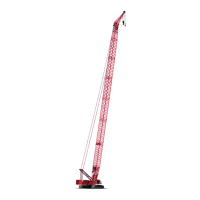Manitowoc Published 05-03-17, Control # 228-03 1-17
16000 SERVICE/MAINTENANCE MANUAL INTRODUCTION
back to minimum displacement when in motion if the load is
below a preset pressure of 270 bar (3,916 psi). Depending
on the motor system, the servo uses the low pressure
accessory system pressure to perform the shifting operation.
Servo control fluid shifts the shuttle valve and servo control
valve before entering the servo cylinder.
Continuous changing of closed-loop fluid occurs through
leakage in pumps, motors, and loop flushing valves. Motor
case fluid drainage lubricates the motor and provides a re-
circulation of hydraulic fluid to control heat in the closed-loop
system. Motors also have an internal or external loop
flushing (purge) system that consists of a control valve (17)
and relief valve (18). If the system pressure is above 14 bar
(203 psi), loop flushing removes 15 Lpm (4 gpm) of hot fluid
from the system for added cooling and purification. If the
system pressure is under 14 bar (203 psi) loop flush is
disabled.
Accessory/MAX-ER Pump
The accessory/MAX-ER pump is the source of pressure for
the accessory system components. The programmable
controller controls the pump output pressure when an
accessory valve is enabled.
The accessory/MAX-ER pump supplies hydraulic fluid to
operate the jacking cylinders, pin cylinders, mast raising
cylinders, rigging winch, and cab tilt cylinder. Accessory
pump pressure is reduced from 207 bar to 35 bar (3,000 to
508 psi). Pressure at standby is 28 bar (406 psi) by the
reducing valve for the travel brake, travel two-speed, and
swing brake.
NOTE: An external pump on the engine operates the
engine cooling fan. The accessory pump also
controls the cooling fan. Tier 4 equipped machines
will have a variable speed cooling fan.
Engine Controls
See the engine manufacturer’s manual for instructions.
The engine key switch starts and stops the engine. The
engine clutch lever for the pump drive must be manually
engaged for normal operation.
Crane systems speed depends on engine speed and system
control handle movement. The engine speed is controlled
with the hand throttle or foot throttle and is monitored with a
speed sensor. Node-1 and engine Node-0 controllers control
and process engine information and display the information
on the main display.
In an emergency, the emergency stop button stops the
engine, applies all brakes, and stops all functions abruptly.
ELECTRICAL CONTROL SYSTEM
See Figure 1-10 for the following procedure.
The crane’s boom, load lines, swing, crawler tracks, and
accessory components are controlled electronically with the
EPIC (Electrical Processed Independent Control) with CAN-
bus (Controller Area Network) technology. The 24 volt CAN-
bus programmable controller system uses remote nodes that
contain controllers. The node controllers communicate with
the Node-1 (master) controller by sending data packets over
a two-wire bus line. The data packets are tagged with
addresses that identify system components. The Node-1
controller compares these input data packet signals with
programming directives and data information.The Node-1
controller then provides the appropriate output voltage
commands to the remote node controllers.
Each node controller receives and sends both analog and
digital input/output voltages. Analog input/output voltages
are either AC or DC variable voltages or currents. Digital
input/output voltages are zero volts (no voltage) or 24 volts.
Node controllers use the binary system. The binary system is
based on binary multiples of two and only recognizes 0 =
OFF or 1 = ON. Basic counts of this system are exponents of
the number two. These exponents are formed in words,
called bytes, of eight numbers each. The eight numbers are
1, 2, 4, 8, 16, 32, 64, and 128 for an 8-bit controller or a
combination of up to 255 bytes. These bytes represent
electrical inputs/outputs to the Node-1 controller.
Remote nodes on the boom monitor the boom, luffing jib, or
fixed jib components and input the information to the Node-1
controller. Boom components include angle sensors, block-
up limits, and load pin sensors. The mast angle position is
also monitored.
The system nodes controllers are listed below:
Node-1—Master (Front Console) Cab Controls
Node-2—Handles and Cab Controls
Node-3—Pumps, Accessories, Alarms, and Drum 4
Node-4—Accessories, Diverting, and Pressure Senders
Node-5—Sensors, Limits, Swing and Travel Components
Node-6—Drum 1, 3, and 5 Components
Node 7—MAX-ER
Node-20—Boom
Node-21—Luffing or Fixed Jib
Node-0—Engine

